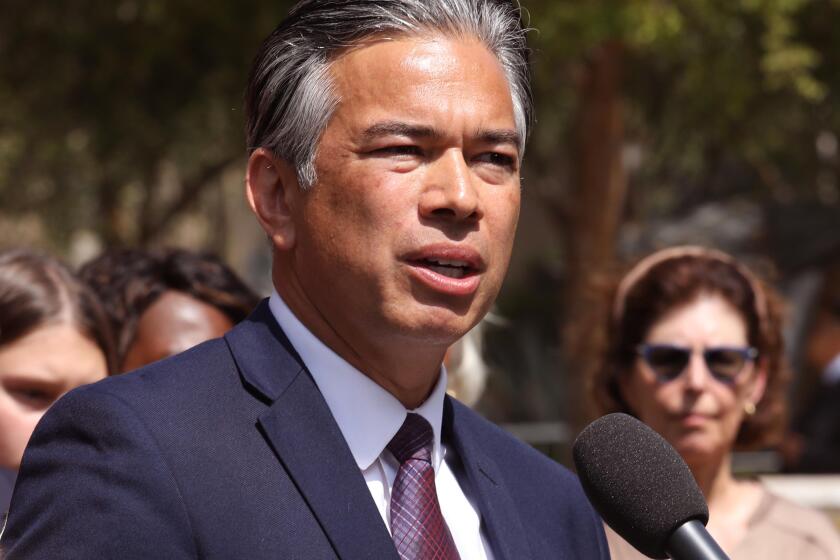Checkups Not So Regular for Latinas
- Share via
For reasons ranging from poor access to medical care to cultural attitudes toward sickness and health, Latino women are less likely than either white or African American women to have had a gynecological checkup in the last year, or two years--or ever.
A national survey has found that more than one in three Latinas said they hadn’t had a routine gynecological or prenatal exam in the last year. Nearly a quarter hadn’t had one in at least two years. And more than one in 10 said they had never had such an exam.
Lack of insurance, no regular doctor and long waits to get a referral were cited by women as reasons for not seeking care, according to the survey by the Henry J. Kaiser Family Foundation and the Los Angeles Times.
Health care experts said the survey results are cause for concern because Latinas are at higher risk for some illnesses.
Cervical cancer rates among Latinas are nearly double those of the general population, according to a report released last month by the American Cancer Society, National Cancer Institute and the Centers for Disease Control and Prevention.
The higher rate could be a consequence of a lack of routine exams, says Robert Greenlee, program director of cancer surveillance at the American Cancer Society. Pap smears can catch cervical abnormalities, which can be treated before they develop into full-fledged cancers.
There are other health concerns too. Breast cancer, though less common among Latinas than other women, tends to be detected at a more advanced stage in Latinas, when it’s harder to treat.
And although HIV infection rates are slightly decreasing in white and African American populations, they are increasing in Latinos generally and in women in particular, the CDC reports. In Latinas, the disease is spread primarily through unprotected heterosexual sex.
Medical experts have recommended guidelines for what tests, counseling and other services women should receive during an annual gynecological visit: Pap smear, breast exam, and treatment and counseling about sexually transmitted diseases and safe sex practices.
*
So why are Latinas receiving fewer of these services?
There are many reasons. Chief among them, health care experts say, is lack of adequate medical insurance.
In California, for example, 39% of Latinas under age 65 lack insurance, according to a study released last week by UCLA’s Center for Health Policy Research. That’s because Latinos often work in jobs or for small businesses that don’t provide such coverage. And their wages often are too low to afford to pay the health insurance contribution required by employers or to afford private insurance, says E. Richard Brown, the center’s director.
Women who are pregnant or have children tend to have better coverage than men, because they often are eligible for federal- and state-funded health care programs, such as Medicaid.
If insurance is one big barrier to good women’s health care, it isn’t the only one.
“Let’s face it--we all drag our heels about getting a Pap smear,” says Diane Chamberlain, chief operating officer of the Valley Community Clinic in North Hollywood, which has many Latina patients.
So imagine what it’s like, she says, when you’re dealing with transportation, language and child-care problems, plus a perception--in a largely Catholic population--that gynecological checkups are mostly about birth control.
There is modesty, too, and fear of the Immigration and Naturalization Service.
“Many women are scared to come in. They think it will interfere with their immigration status. They often ask about that when I’m filling out their paperwork,” says Arlin Donis, a health care worker with the Valley Community Clinic. “Or they’re really embarrassed about showing their private body parts.’
And then there’s the whole notion of going to the doctor when you’re not even sick.
“If we do not have a lot of consciousness about prevention in the United States, prevention in Latin American countries is nil,” says Dr. Aliza Lifshitz, a Los Angeles internist who sees many Latino patients and has a medical talk show on Radio Unica, a Spanish-language radio network. “If you’re not sick, you don’t go.”
Even when people do get sick, they often will try a grandmother’s or neighbor’s herbal tea before going to a clinic, she says.
“If that doesn’t work, you may try a healer,” Lifshitz says. “And if the healer doesn’t work, then you go to the doctor.”
*
What’s the solution? How can more Latinas get the regular checkups they need?
Better access to health insurance is one obvious need, not only for the Latino population but for other underserved groups, Brown says.
Even so, many uninsured women can still get low-cost or free gynecological exams. For a referral to a nearby community clinic, you can call these toll-free hotlines: Los Angeles County, (800) 427-8700; the state’s Breast Cancer Early Detection Program, (800) 511-2300; and the California Family Health Council, (888) 882-2342. Information is available in Spanish as well as English. Outreach is important too.
“If we could get more clinics to the people, instead of requiring people to come to us, I think that would be helpful,” says Nancy Sasaki, president and chief executive of Planned Parenthood Los Angeles.
Community clinics are trying. Twice a week, health worker Donis camps out with a nurse practitioner at the Maud Booth Family Center in North Hollywood, which also houses a day care center where mothers come and go. They counsel the women on birth control. They give breast exams and refer patients to the main clinic for Pap smears. When the weather is warm, they sit outside and strike up conversations with women walking by, hoping to draw them in.
Planned Parenthood, meanwhile, has a mobile clinic it takes into the community to serve hard-to-reach populations. The approach seems to be working.
“At Planned Parenthood, most of our patients are under the age of 29,” Sasaki says. “Yet with the mobile unit, 99% of the women we serve are over age 35. We’re reaching women that would not typically go to a clinic.”
(BEGIN TEXT OF INFOBOX / INFOGRAPHIC)
The Role of Insurance
While many uninsured women receive no regular gynecological care, those who do report receiving about the same level of care as women who have private insurance. About half of the women in both groups reported that they received half or fewer of the recommended tests and counseling. Women on Medicaid tended to get more of the recommended services.
Privately insured
Some tests and counseling: 50%
Half or fewer of tests and counseling: 46%
All tests and counseling: 4%
*
Medicaid
Some tests and counseling: 58%
Half or fewer of tests and counseling: 20%
All tests and counseling: 22%
*
Uninsured
Some tests and counseling: 45%
Half or fewer of tests and counseling: 47%
All tests and counseling: 8%
Source: Kaiser Family Foundation
More to Read
Sign up for Essential California
The most important California stories and recommendations in your inbox every morning.
You may occasionally receive promotional content from the Los Angeles Times.










